Hyman J. Warsager
Hyman J. Warsager (1909–1974) was an American artist known for his printmaking.
Hyman J. Warsager | |
|---|---|
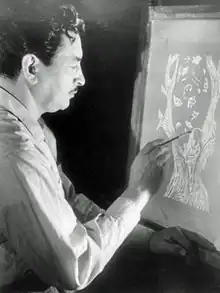 Hyman J. Warsager at work | |
| Born | 1909 New York, New York |
| Died | 1974 (aged 64–65) Buckinghamshire, England, United Kingdom |
| Nationality | American |
| Known for | painter, printmaker |
Biography
Warsager was born in 1909 in New York City. He attended the Pratt Institute, the Grand Central School of Art, and the American Artists School.[1] He worked for the Federal Art Project of the Works Progress Administration (WPA) creating prints.[2][3] His work was included in the 1940 exhibition at the Museum of Modern Art entitled American Color Prints Under $10,[4] which was aimed at bringing public attention to these “inexpensive but dynamic artworks”; the effort was reportedly successful.[5] His work was also included in the 1944 Dallas Museum of Art exhibition of the National Serigraph Society.[6] He died in 1974[7] in Buckinghamshire, England, United Kingdom.[8]
Warsager was among the ‘radical illustrators’[9] who contributed anti-lynching and antifascism images to leftist political magazines in the 1930s with the aim of increasing awareness of racial terrorism being committed across the country as well as the rise of fascism in Europe. His drawing The Law, which appeared in New Masses in 1934, "exemplified the joining of antiracist and antifascist references to critique. . social failures."[10]
He illustrated the label of folk singer-songwriter Earl Hawley Robinson’s 1940 recording Earl Robinson: Songs for Americans, a 78 RPM 4-pocket album released in the U.S.[11] [12] Robinson was one of the "new folk" artists of the Public Works Administration (P.W.A.), a New Deal government agency (1933-39), and he wrote the songs Joe Hill, Black and White, and the cantata Ballad for Americans. His various songs were recorded by Paul Robeson, Lead Belly, Frank Sinatra, Bing Crosby, Odetta, Burl Ives, Three Dog Night, Sammy Davis Jr., Pete Seeger, and Joan Baez.[11]
Federal Art Project – WPA
In the late 1930's Warsager was a member of the WPA team in New York City that experimented with silkscreen techniques. The team was led and inspired by Anthony Velonis.[13] Warsager later recalled that "the establishment of the Graphic division of the WPA/FAP in that memorable fall of 1935 injected new hope in the artists and a new life into the print".[14][15]
Art historian Helen Manga wrote in Radical Art: Printmaking and the Left in 1930's New York: “The credibility that printmaking gained through the establishment of the Federal Art Projects’s Graphic Arts Division. . . increased interest in viewing and collecting modern fine art prints in the second half of the decade (1930’s). The Graphic Arts Division was part of the Federal Art Project. . .initiated in 1935 to promoted work relief for visual artists. . . enabling them to maintain and improve their professional skills. . . .It represented a visionary attempt to combine economic relief for creative artists with the cultural enrichment of the nation”.[16]
About the original Federal Art Project team focused on silk screen printing, Manga wrote: "The team of six artists at the Graphic Arts Division who pioneered new screen-print technologies included Harry Gottlieb, Louis Lozowick, Eugene Morley, Elizabeth Olds, and Hyman Warsager. Harry Sternberg was also working independently on silkscreen printing with help from several other artists",[17] including Ruth Chaney.
The early experimentation by Velonis in combination with the instructional booklet he wrote for the WPA[18] and the WPA Federal Art Project team's collective efforts "would ultimately transform silkscreen printing from a commercial process to a fine-art medium".[19]
Warsager and Velonis were longtime friends, collaborators, and later business partners. In an essay written in 1941, Carl Zigrosser, then curator of prints, drawings, and rare books at the Philadelphia Museum of Art, wrote: "Warsager has long been associated with Velonis; indeed he has shared a studio with him for the last few years and has also engaged in business with him under the name of Creative Printmakers Group".[20]
Creative Printmakers Group
In 1939, Velonis, Warsager and other artists co-founded the Creative Printmakers Group in New York City.[21][22] About this group, Sylvie Covey wrote in Modern Printmaking: A Guide to Traditional and Digital Techniques: "The group's shared screen-printing studio introduced the silkscreen process to many serious artists who went there to have editions printed. Vincent Longo worked as a colorist at Creative Printmakers Group, as did Jackson Pollock, and the print shop eventually became the most important silkscreen shop of the era. It was at about this time that the word serigraphy, which combines the Latin word seri ("silk") and the Greek word grapho ("to write"), first appeared. It was coined by Carl Zigrosser . . . . to distinguish fine-art from commercial silkscreen""[23].
Warsager was acquainted with the French-American artist Louise Bourgeois when they were both in their late twenties in New York City. In June of 1939, Bourgeois visited him at the studio of Creative Printmakers Group in Manhattan.[24] Later that summer, during her trip to Paris, Bourgeois sent him a hand-written letter[25] about organizing an exhibition with André Lurçat, the French architect, urban planner and painter, at Maison de la Culture in Paris, where Lurçat was also the manager. She wrote: “I have shown him [Lurçat] your three prints and some work by Ruth Chaney and some by Will Barnet. He likes them very much”.[26]
National Serigraph Society
Warsager, Velonis, Joseph LeBoit, Max Arthur Cohn and several other artists founded the National Serigraph Society in 1940,[21] which held exhibits, operated a gallery,[27] and published a newsletter. The Society was called a "major force in the development of serigraphy as a fine art. . .(that) set standards of excellence and has sent hundreds of exhibitions of its members' work to countries all over the world" in Silk-Screen Printing for Artists & Craftsmen (1970) [28] by Mathilda V. and James A. Schwalbach. The authors added that the exhibitions were responsible for a good deal of museum interest in the purchase of original prints as part of museum collections. The organization was described as "a source of inspiration, a clearing house, and temple of artist and print makers everywhere" in Silk Screen Techniques[29] by J.I. Biegeleisen and Max Arthur Cohn, who noted that it was largely responsible for the effective promotion of serigraphy, raising it to the level of a museum art form. The Society's "active program of traveling exhibits, lectures, and portfolios of prints helped to sustain and broaden interest in the serigraph".[30]
The Dallas Museum of Art held several exhibits of the work of the National serigraph Society members in 1944, 1947, and 1951[31][32] [33]
Service in U.S. Army Air Forces Silk Screen Unit
Warsager served in the U.S. Army Air Forces' Western Technical Training Command (AAFWTTC) in Denver, CO from 1942 to 1945,[34] where he taught aerial photography in the U.S. Army Air Forces School. Based on his art training and experience, Warsager was assigned to head a new Silk Screen Unit for the design and production of color posters on various subjects that the Command wished to publicize.[21][22] The commanding general of the AAFWTTC, Major General John F. Curry, wrote in a November 1943 commendation: “I wish to commend the Silk Screen Unit of the Reproduction Division at Lowry Field for the intelligence, imagination and originality displayed in designing and executing the posters requested by this headquarters for distribution to the various stations of this command. . . . The (Silk Screen) unit. . .has successfully been engaged in producing posters which have been accorded high praise from many sources. I particularly desire to commend . . .. Staff Sergeant Hyman J. Warsager for setting up the unit and for executing and directing the production of the posters. . .”.[35]
Warsager and fellow artists in the unit designed and created a mural in the map room of the Operations Building at Lowry Field, at the suggestion of Brig. Gen. Albert L. Sneed, to "make Lowry one of the most talked of stations among pilots on the Chicago to San Francisco airway."[36]
Anthony Velonis also served in this military Silk Screen Unit after Warsager requested that the Army Air Forces assign Velonis to the unit, based on Velonis' strong technical screen printing skills and expertise.[18]
Decorative Glassware Company
In 1940 Warsager and Velonis started a commercial company by building on their screen printing skills and experience. They called the company Ceraglass, with ‘cera’ referring to ceramic. The business had its beginnings in a chance encounter, as noted in various sources[21][37][38][39][40]. Ceraglass evolved from their previous endeavor, Creative Printmakers Group, which they had started with several other artists. Along with the work of numerous artists, Creative Printmakers printed holiday cards for the Metropolitan Museum of Art. A cosmetics manufacturer spotted Warsager’s and Velonis' work and then visited them at the studio they shared, where he inquired whether the silk-screen process with which they were expert could be used on glass to produce an attractive bottle for a men’s shaving lotion. He persuaded them to decorate cosmetic containers.
Encouraged by the success of that side venture, Warsager and Velonis formed their own firm and later decorated containers for cosmetic manufacturers such as Elizabeth Arden, Dorothy Gray and Shulton.[37] Eventually, Ceraglass turned to creating decoration for glassware. By 1962 they led a team of seven artists and designers and their team of skilled craftsmen. The company employed a hundred and fifty skilled and semiskilled employees, most of whom had been trained on-the-job.[38] By the mid-1960’s the company had outgrown its multiple loft sites in New York City and moved to progressively larger spaces. By 1965 Ceraglass and its affiliated company Ceragraphic occupied 56,000 square feet of factory and design space in Hackensack, NJ.[21]
Velonis and Warsager operated Ceraglass and Ceragraphic until they sold the firms to VCA Corporation in 1969. Warsager stayed for several more years as Chief Executive Officer. He held several U.S. patents on glassware designs.[41] Velonis held patents on innovative processes involved in their manufacturing process;[42] in addition to being an artist, Velonis was technically skilled and developed many of the paints and techniques used in their production processes.
The Museum of American Glass in West Virginia holds numerous glassware items in its collection that were designed and produced by Ceragraphic and Ceraglass.[43]
Selected Group Exhibitions
- 1937 National Exhibition, International Art Center,[44][45] New York, Master Institute of United Arts, Prints for the People, Federal Art Project - Works Progress Administration, Jan. 4 - 31
- 1938 Brooklyn Museum,[46] Color Prints by Four W.P.A. Artists (Russell Limbach, Augustus Peck, Louis Schanker, Hyman Warsager), May 27 - Sept. 5
- 1939 The Berkshire Museum, Pittsfield, MA.,The World of Today, organized by Elizabeth McCausland, July 26 - August 16[47][48]
- 1940 Springfield Museum of Art,[49] organized by Elizabeth McCausland[50] for The Silkscreen Group (later re-named the National Serigraph Society).
- 1940 Brooklyn Museum,[51] Silk Screen Process Prints. Sept. 20-Oct. 20
- 1940 New York State Museum, Albany, N.Y., Silk Screen Exhibit[52][53]
- 1940 Museum of Modern Art,[4] American Color Prints Under $10, Nov. 25-Dec. 24
- 1940 Whitney Museum of American Art,[54] Annual Exhibition of Contemporary American Art - Sculpture, Paintings, Watercolors, Drawings, Prints. Jan. 10-Feb. 18
- 1941 Whitney Museum of American Art,[55] Annual Exhibition of Contemporary American Sculpture, Watercolors, Drawings and Prints. Jan. 15-Feb. 19
- 1942 Whitney Museum of American Art,[54] Annual Exhibition of Contemporary American Art - Sculpture, Paintings, Watercolors, Drawings and Prints. Nov. 24, 1942-Jan. 6, 1943
- 1942 The Metropolitan Museum of Art,[56] Artists for Victory - An Exhibition of Contemporary American Art. June
- 1944 Santa Barbara Museum of Art,[57] Serigraphs by Sergeant Hyman Warsager, December
- 1991 Boston Museum of Fine Arts,[58] American Screenprints: 1930s-1960s. September
- 1996 The Metropolitan Museum of Art,[59] W.P.A. Color Prints: Images from the Federal Art Project. March 5-May 26
- 2001 Bruce Museum,[60] Prints of American Life: WPA Works on Paper from the Webster Collection. Sept. 1-Nov.25
- 2011 Asheville Art Museum,[61] Artists at Work: American Printmakers and the WPA. April 29-Sept. 25
- 2016 Philadelphia Museum of Art,[62] Breaking Ground: Printmaking in the U.S., 1940-1960. May
- 2017-2018 Zimmerli Art Museum, Rutgers, Serigraphy: The Rise of Screenprinting in America, Sept. 5-Feb.11
- 2023 Brooklyn College, A New Deal for Artists: Connecting Brooklyn College to Its Past, Present, and Future, New Deal Exhibit: Federal Art Project.[63]
Museums
Warsager's work is in the Art Institute of Chicago,[64] the Baltimore Museum of Art,[65] the Brooklyn Museum,[66] the Detroit Institute of Arts,[67] the Metropolitan Museum of Art,[68] the National Gallery of Art,[69] Philadelphia Museum of Art,[70] the Smithsonian American Art Museum,[7] the Victoria and Albert Museum,[71] the University of Arizona Museum of Art,[72] the University of Michigan Museum of Art,[73] Blanton Museum of Art at the University of Texas at Austin,[74] the Illinois State Museum,[75] Krannert Art Museum,[76] Weisman Art Museum,[77] The Block Museum of Art at Northwestern University,[78] Museum of Fine Arts Boston,[79] the Harn Museum of Art[80] at University of Florida, Davison Art Center at Wesleyan University,[81] Yale University Art Gallery,[82] Jordan Schnitzer Museum of Art[83] at the University of Oregon, and the Whitney Museum of American Art.[55]
Gallery
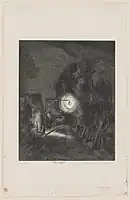 Nocturne, c.1936, etching
Nocturne, c.1936, etching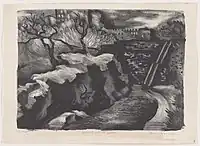 Washington Heights, c.1937, lithograph
Washington Heights, c.1937, lithograph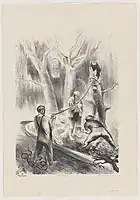 Tree Surgeons, c.1939, lithograph
Tree Surgeons, c.1939, lithograph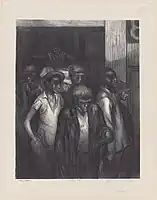 Shape Up, c.1938, lithograph
Shape Up, c.1938, lithograph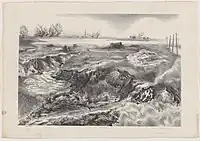 Canarsie Meadows, c.1937, lithograph
Canarsie Meadows, c.1937, lithograph Sea Wall
Sea Wall
References
- "Hyman Warsager". AskArt. Retrieved 16 June 2022.
- "Hyman Joseph Warsager Biography". Annex Galleries Fine Prints. Retrieved 16 June 2022.
- "On the Avenue". Prints: New Deal Art (WPA/PWAP) Krannert Art Museum. Retrieved 16 June 2022.
- "American Color Prints Under $10". The Museum of Modern Art. Retrieved 20 September 2022.
- Langa, Helen (2004). Radical Art: Printmaking and the Left in 1930's New York. Berkeley and Los Angeles, California: University of California Press. p. 36. ISBN 0-520-23155-4.
- "National Serigraph Society Exhibition | Dallas Museum of Art". Dallas Museum of Art. Retrieved 16 June 2022.
- "Hyman J. Warsager". Smithsonian American Art Museum. Retrieved 16 June 2022.
- "Familysearch.org". familysearch.org. 24 June 2022.
- Morgan, Stacy I. (2004). Rethinking Social Realism: African American Art and Literature, 1930-1953. Athens, Georgia: The University of Georgia Press. p. 130. ISBN 0-8203-2579-1.
- Langa, Helen (2004). Radical Art: Printmaking and the Left in 1930's New York. Berkeley and Los Angeles, California: University of California Press. p. 157. ISBN 0-520-23155-4.
- "Earl Robinson Songs for Americans, Picture art by Hyman Warsager, Timely Record 78". Popsike.com. Retrieved September 23, 2023.
- "Performing Arts Databases - Earl Robinson: Songs for Americans". The Library of Congress. Retrieved September 23, 2023.
- Colescott, Warrington; Hove, Arthur (1999). Progressive Printmakers: Wisconsin Artists and the Print Renaissance. University of Wisconsin Press. p. 5. ISBN 9780299161101.
- Warsager, Hyman (1973). "Graphic Techniques in Progress". In O'Connor, Francis V. (ed.). Art for the Millions: Essays from the 1930's by Artists and Administrators of the WPA Federal Art Project (2nd ed.). Boston, Massachusetts: New York Graphic Society, Ltd. p. 139. ISBN 0-8212-0659-1.
- Watrous, James (1984). A Century of American Printmaking - 1880-1980. Madison, Wisconsin: The University of Wisconsin Press. p. 97. ISBN 0-299-09680-7.
- Langa, Helen (2004). Radical Art: Printmaking and the Left in 1930's New York. Berkeley, Los Angeles, London: University of California Press. pp. 21–22. ISBN 0-52023155-4.
- Langa, Helen (2004). Radical Art: Printmaking and the Left in 1930's New York. Berkeley, Los Angeles, London: University of California Press. p. 250. ISBN 0-52023155-4.
- Velonis, Anthony (1938). Technical Problems of the Artist: Technique of the Silkscreen Process. Federal Art Project, New York. OCLC 4172574.
- Covey, Sylvie (2016). Modern Printmaking: A Guide to Traditional and Digital Techniques. Berkeley: Watson-Guptill. p. 227. ISBN 978-1-60774-759-8.
- Zigrosser, Carl (December 1941). Bender, John (ed.). "The Serigraph, A New Medium". The Print Collector's Quarterly. 28 (4): 457–458.
- "Oral History Interview with Anthony Velonis, 1965, October 13". Archives of American Art, Smithsonian. Retrieved September 3, 2022.
- "Oral History Interview with Hyman J. Warsager, 1965, October 14". Archives of American Art, Smithsonian. Retrieved September 3, 2022.
- Covey, Sylvie (2016). Modern Printmaking: A Guide to Traditional and Digital Techniques. Berkeley: Watson-Guptill. p. 227. ISBN 978-1-60774-759-8.
- Louise Bourgeois, diary entry, 16 June 1939; © The Easton Foundation/VAGA at ARS, NY
- Louise Bourgeois, letter to Hyman Warsager, Summer 1939. 81/4 x 51/4 in. (21x13.3 cm.). LB-2200; © The Easton Foundation/VAGA at ARS, NY
- Louise Bourgeois, letter to Hyman Warsager, Summer 1939. 81/4 x 51/4 in. (21x13.3 cm.). LB-2200; © The Easton Foundation/VAGA at ARS, NY
- Devree, Howard (April 20, 1955). "Serigraph Society's Annual Show Called International Event of Strong Color". The New York Times. Retrieved November 5, 2022.
- Schwalbach, Mathilda V.; Schwalbach, James A. (1970). Silk-Screen Printing for Artists & Craftsmen (Revised ed.). New York: Dover Publications. p. 16. ISBN 9780486157498. LCCN 80-66838.
- Biegeleisen, J.I.; Cohn, Max Arthur (1958). Silk Screen Techniques (2nd ed.). New York: Dover Publications. p. 14. ISBN 9780486204338.
- Ross, John; Romano, Clare; Ross, Tim (1990). The Complete Printmaker: Techniques, Traditions, Innovations (Revised ed.). New York, N.Y.: Free Press (A Division of Simon & Shuster). p. 145. ISBN 9780029273715.
- "National Serigraph Exhibition, January 15-February 15, 1947 [Checklist]". The Portal to Texas History. Retrieved November 5, 2022.
- "National Serigarph Society Exhibition, April 1-May 2, 1951 [Checklist]". The Portal to Texas History. Retrieved November 5, 2022.
- "National Serigraph Society Exhibition". Dallas Museum of Art. Retrieved November 5, 2022.
- Army of the United States - Separation Qualification Record - Discharge: Armed Forces of the United States. Hyman J. Warsager, 32 358 736 Staff Sergeant, 3705th Army Air Forces Base Unit, Honorable Discharge, September 27, 1945, Lowry Field, Colorado (Given at Washington, D.C. on May 15, 1952). W. E. Bergin, Major General, USA, The Adjutant General
- Memorandum - Commendation from Major General John F. Curry, Commanding General, Technical School, AAFWTTC, Lowry Field, Colorado, November 1, 1943, #059378; HQ AAFWTTC, Nov. 1, 1943, 201.22, Authorized by Brigadier General A. L. Sneed.
- "Map Room of Operations Now Sparkles with Mural Done by Silk Screen Staff". The Rev-Meter. Published in the Interests of the Personnel of Lowry Field, Denver, CO. Vol. 4 (14 ed.). August 14, 1944. pp. 1, 3.
- The Gift and Art Buyer, July 1961, Meet Mister H.J. Warsager - Artist and Businessman
- "Eye Appeal, Buy Appeal Go Together, Trio Knows: Hackensack Manufacturers of Bottles Succeed in Turning Out Attractive Products". The Record. Hackensack, NJ. December 24, 1962.
- The American Perfumer and Aromatics (industry publication), December 1959
- Art, Home, and Design, a brochure of the Ceraglass Company, 1965
- "Google Patents". Drinking Glass. Retrieved November 28, 2022.
- "Google Patents". Method of forming a raised metallic design on a vitreous surface. Retrieved November 28, 2022.
- "Museum of American Glass in West Virginia". Retrieved November 28, 2022.
- "Prints for the People: A National Exhibition of Prints". Prints Online - Mary Evans Picture Library - Historic Prints & Wall Art. Retrieved April 6, 2023.
- "Prints for the People: A National Exhibition of Prints". Alamy.com. Retrieved April 6, 2023.
- "Color Prints by Four W.P.A. Artists". Brooklyn Museum. Retrieved February 9, 2023.
- Harris, Ruth (August 13, 1939). "Far From the City Heat: Berkshire Museum Puts on an Instructive Show Called 'The World of Today'". The New York Times (timesmachine.nytimes.com). Retrieved July 12, 2023.
- "Box 26, Folder 62: The Berkshire Museum, "The World of Tomorrow" Exhibition, 1939". Smithsonian Institution Collections, Elizabeth McCausland Papers. 1939. Retrieved July 14, 2023.
- Langa, Helen (2004). Radical Art: Printmaking and the Left in 1930's New York. Berkeley, Los Angeles, London: University of California Press. p. 221. ISBN 0-52023155-4.
- "Elizabeth McCausland, Critic and Idealist". Archives of American Art Journal. 6 (2): 18. April 1966. JSTOR 1556916 – via JSTOR.
- "Silk Screen Prints". Brooklyn Museum Bulletin. 2 (1). 1940. JSTOR 26458042. Retrieved November 11, 2022.
- "Elizabeth McCausland Papers". Smithsonian Archives of American Art. Retrieved July 15, 2023.
- "Box 26, Folder 66: New York State Museum, Silk Screen Exhibition, 1940". Smithsonian Archives of American Art. Retrieved July 15, 2023.
- "Whitney Museum of American Art". Hyman Warsager Exhibitions. Retrieved November 11, 2022.
- "Whitney Museum of Art". Hyman Warsager Exhibitions. Retrieved November 11, 2022.
- "The Met: Watson Library Digital Collections". Artists for Victory: An Exhibition of Contemporary American Art. Retrieved November 11, 2022.
- "Exhibition Title" (PDF). Santa Barbara Museum of Art (sbma.net). Retrieved June 9, 2023.
- "Tech.MIT.edu". American Screenprints celebrates the art form. Retrieved November 11, 2022.
- "The Met: Watson Library Digital Collections". W.P.A. Color Prints: Images from the Federal Art Project, 1996_006-001. Retrieved November 11, 2022.
- "Antiques and the Arts Weekly". Bruce Museum Examines the WPA's Prints of American Life. Retrieved November 11, 2022.
- "kimzdanowick.weebly" (PDF). Ashville Art Museum Profile, Volume 63, Number 1, January-April 2011. Retrieved November 11, 2022.
- "Philadelphia Museum of Art". Breaking Ground: Printmaking in the US, 1940-1960. Retrieved November 11, 2022.
- "New Deal Exhibit: Federal Art Project - An Online Catalog for the Exhibit at Brooklyn College". A New Deal for Artists: Connecting Brooklyn College to its Past, Present, and Future. Retrieved July 20, 2023.
- "Art Institute of Chicago". Art Institute of Chicago. Retrieved July 5, 2022.
- "Hyman J. Warsager". Baltimore Museum of Art. Retrieved 16 June 2022.
- "Along Harlem River". Brooklyn Museum. Retrieved 16 June 2022.
- "Squash Hollow". Detroit Institute of Arts. Retrieved 27 June 2022.
- "Nocturne". Metropolitan Museum of Art. Retrieved 16 June 2022.
- "Hyman J. Warsager". National Gallery of Art. Retrieved 16 June 2022.
- "Prospect Park". Philadelphia Museum of Art. Retrieved 16 June 2022.
- "V&A - Prints, Drawings & Paintings Collections". Victoria and Albert Museum.
- "Hyman Warsager - Doctor's Office". The University of Arizona Museum of Art. Retrieved September 21, 2022.
- "Sea Wall - Hyman Warsager". University of Michigan Library, Library Digital Collections, University of Michigan Museum of Art. Retrieved September 21, 2022.
- "Winter Scene - Hyman Warsager". Blanton Museum of Art. Retrieved September 21, 2022.
- "Shape Up - Hyman Warsager". Illinois State Museum Collections Online - The Works Progress Administration (WPA) Collection. Retrieved September 21, 2022.
- "On the Avenue". KAM - University of Illinois Urbana-Champaign. Retrieved September 21, 2022.
- "Squash Hollow". Weisman Art Museum Collection. Retrieved September 23, 2022.
- "Hyman Warsager". The Block Museum of Art. Retrieved September 26, 2022.
- "Gathering Logs". MFA Boston. Retrieved September 29, 2022.
- "Gathering Logs, Nocturne". Harn Museum of Art. Retrieved October 18, 2022.
- "Along the Harlem River - Hyman J. Warsager". Wesleyan University Davison Art Center. Retrieved October 20, 2022.
- "Gathering Logs". Yale University Art Gallery. Retrieved October 20, 2022.
- "Explore Art". University of Oregon - Collections - Jordan Schnitzer Museum of Art. Retrieved June 21, 2023.
External links
 Media related to Hyman J. Warsager at Wikimedia Commons
Media related to Hyman J. Warsager at Wikimedia Commons